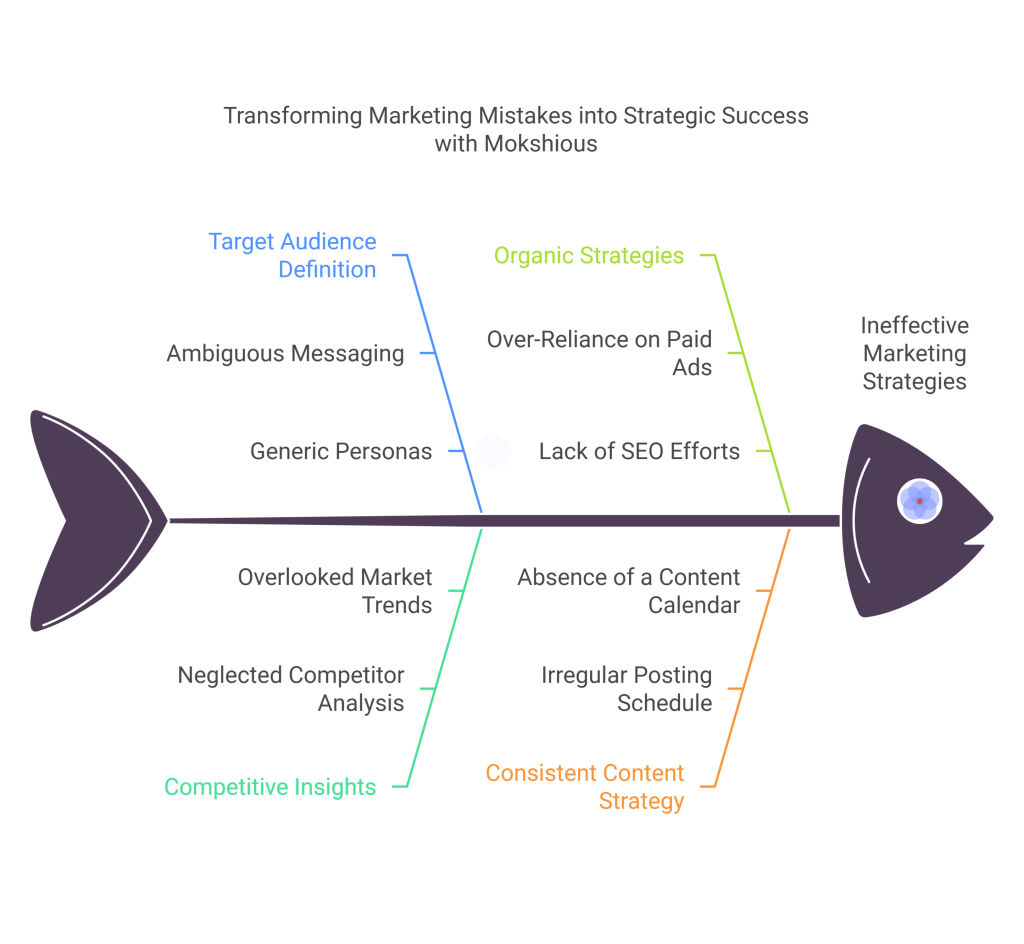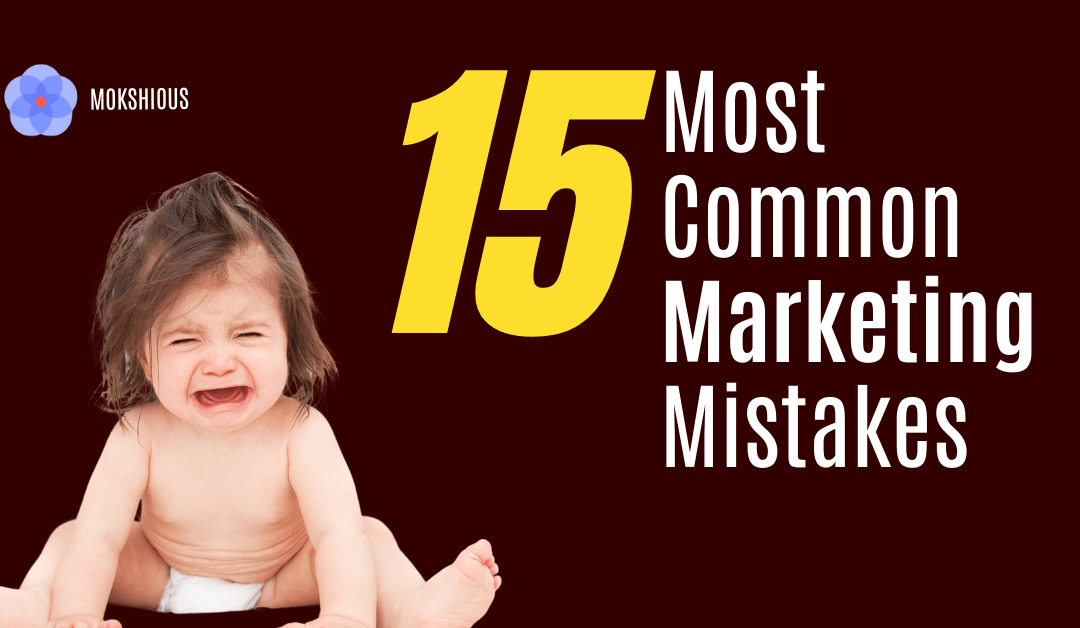In a digital landscape crowded with fast-evolving solutions and disruptive business models, marketing blunders can stealthily drain precious resources and stunt business growth. When you consistently refine your marketing strategy, you not only elevate brand awareness but also enhance social media advertising efforts; We Earn long-term trust.
Below is a comprehensive exploration of the most common marketing mistakes and how you can transform these pitfalls into strategic triumphs.
We’ll delve into demographic and psychographic insights, and provide actionable fixes that can help you refine your approach – no matter the size of your enterprise.
1. Not Defining Your Target Audience Clearly

1.1 Understanding the Cost of Ambiguity
If you fail to specify whom you’re speaking to, you’ll likely end up talking to no one at all. According to marketing experts, effective strategies can lead to significant growth. In a 2024 HubSpot survey, companies that segment Their marketing team should focus on avoiding the worst marketing mistakes. Audiences see a 760% increase in revenue compared to those that don’t, highlighting a common mistake many businesses make. Without a clear audience definition, your campaigns may become scattershot of disconnected messages – too general to resonate, too broad to engage.
1.2 Recognizing the Red Flags
- Low CTR and Conversion Rates: If your promotions feel “one-size-fits-all,” audiences simply skim over them.
- Generic User Personas: Fuzzy personas that lack demographic detail or psychographic nuance often signal poor audience definition, which is a mistake many small business owners make.
1.3 Actionable Steps to Refine Targeting
- In-Depth Market Research: Use focus groups, surveys, and social listening tools to uncover real pain points.
- Robust Personas: Develop data-driven profiles that capture not just age or role but also motives, fears, and aspirations to ensure that your marketing efforts are effective.
- Behavioral Segmentation: Cluster users based on content interests, usage patterns, or funnel phase to make marketing resonate.
2. Competitive Insights

2.1 Why Competitive Insights Matter
Businesses comes with new competitors emerging at an alarming rate, and therefore, marketers have to be proactive about what is happening concerning their business; this can profoundly boost the performance of marketing. There are digital tools and techniques of marketing which, if neglected about what competitors are doing, puts you in the echo chamber and hence leads to mistakes in marketing. Data from SEMrush indicates that businesses conducting competitor analysis at least quarterly see up to a 30% uptick in marketing performance.
2.2 Effective Tools and Techniques
- Specialized Platforms: SEMrush, Ahrefs, and Similarweb reveal keyword gaps, backlink sources, and trending content.
- Social listening: Monitor community forums, LinkedIn groups, and industry newsletters to spot emerging strategies and help you avoid common small business marketing mistakes for small business owners.
2.3 Implementing Competitor Insights
- Content Gaps: Identify topics your rivals haven’t covered and address them compellingly.
- Pricing Benchmarks: Understand competitors’ price models and promotions to position your offering advantageously.
3. Organic strategies
3.1 The Pitfalls of Over-Reliance
Relying entirely on paid campaigns can be an expensive hamster wheel, especially for small business owners who should also explore organic strategies. According to WordStream’s latest report, average CPCs are climbing 15% year-over-year in competitive SaaS niches. A lack of organic or referral traffic leaves you vulnerable if ad costs spike or channels underperform, which is one marketing mistake that is imperative to avoid.
3.2 Diversifying Your Reach
- SEO & Content Marketing High-ranking blog posts and long-tail keywords foster sustained traffic, which is essential for small business marketing.
- Email Marketing: A McKinsey study suggests email is up to 40 times more effective at acquisition than social media.
- Influencer Partnerships: It can be established through collaboration with industry thought leaders that credibility and trust are essential for successful marketing.
3.3 Balancing the Equation
- Measure Paid vs. Organic ROI: Track CAC (Customer Acquisition Cost) across both fronts.
- Test and Iterate: Run A/B tests to find the most effective strategies for successful marketing campaigns. The right strategies can help avoid common marketing errors. Equilibrium of channels.
4. Neglecting a consistent content strategy can lead to marketing campaign failure
4.1 Why Consistency is Non-Negotiable
Consistency builds familiarity and authority, making it a do for effective small business marketing. Content Marketing Institute reported that from a 2023 survey, companies posting weekly attracted 3.5x more traffic than those doing it sporadically , which is one of the common factors to avoid small business marketing mistakes.
4.2 Building a Reliable Content Calendar
- Editorial Workflows: Tools like ClickUp, Proofhub, Asana or Trello streamline assignments, deadlines, and topic ideation.
- Topic Mapping: Organize your content by themes—ERP best practices, CRM integrations, or Project Management hacks—to maintain relevance.
4.3 Content Varieties That Work
- Evergreen Posts: Long-lasting guides that address ongoing needs, like “How to Integrate a Payment Gateway Seamlessly.”
- Thought Leadership: Whitepapers and trend analyses that show your finger is firmly on the pulse of emerging technologies.
5. Overlooking Mobile Optimization
5.1 The Mobile-First Imperative

As of 2024, over 60% of B2B searches occur on mobile devices. A site or funnel poorly optimized for smartphones can bleed leads faster than you can generate them.
5.2 Ensuring a Mobile-Friendly Experience
- Mobile Testing: Utilize Google’s Mobile-Friendly Test and Lighthouse audits to find obvious errors in your digital marketing practices
- Responsive Design: Implement fluid grids, flexible images, and intuitive navigation patterns for smaller screens.
5.3 Mobile-Optimized Assets
- Email Templates: Keep subject lines short and include a prominent CTA button.
- Landing Pages: Reduce clutter; ensure forms are easy to complete on a phone.
6. Skipping Email Marketing
6.1 A High-ROI Channel You Can’t Ignore
Studies by Litmus show email can yield $36 for every $1 spent. Abandoning email marketing means forgoing a powerful, permission-based engagement vehicle.
6.2 Growing Your Subscriber Base
- Lead Magnets: Offer a compelling resource – an in-depth ERP implementation checklist, for example – to encourage sign-ups and meet your marketing goals.
- Personalized Drip Campaigns: Segment lists by user stage (e.g., “new user,” “trial expiring,” “premium client”) to tailor messaging in every marketing initiative.
6.3 Crafting Emails That Get Results
- Subject Line Optimization: A/B test subject lines to increase open rates and improve your marketing messages.
- Storytelling and Value: Each email should add value: tips, case studies, or exclusive insights that strengthen user trust.
7. Ignoring Analytics
7.1 Data-Driven Marketing Is the New Norm
In a world awash with marketing channels, instincts alone fall short of creating a marketing strategy that works. According to Forbes, data-centric companies are 23x more likely to win new customers. Ignoring analytics is like flying blind.
7.2 Vital Metrics to Track
- Website Metrics: Monitor bounce rates, session duration, and scroll depth.
- Campaign Metrics: Track CTR, conversion rates, and CAC to understand what’s working.
7.3 Analytics Toolset
- Google Analytics 4 (GA4): Enhanced event tracking and AI insights.
- Dashboard tools like Databox or Looker (now part of Google Cloud) are essential for clear KPI visualizations in your marketing campaign.
8. Underestimating the Power of Social Proof
8.1 Psychological Leverage
People trust peers. Nielsen reports 92% of consumers trust recommendations from people they know, and even strangers’ opinions influence purchasing decisions. Harnessing user reviews, testimonials, and case studies can skyrocket credibility in internet marketing.
8.2 Showcasing Authentic Proof
- Video Testimonials: A powerful tool in online marketing. A short 60-second video from a satisfied client can overshadow a thousand words.
- Customer Success Stories: Highlight before-and-after scenarios to illustrate tangible business outcomes.
8.3 Encouraging User-Generated Content
- Hashtag Campaigns: Invite users to share experiences on social platforms, creating a mosaic of authentic voices.
- Review Incentives: Offer small perks for honest reviews to bolster your brand’s reputation.
9. Forgetting to Optimize for SEO
9.1 The Marathon, Not a Sprint
Unlike paid ads, SEO compounds over time. HubSpot notes that 75% of users never scroll past the first page of search results. Good rankings yield recurring visibility without recurring spend.
9.2 Immediate Wins in SEO
- On-Page Optimization: Streamline meta tags, headers, and internal linking.
- Speed Enhancements: Every second of load time reduction can boost conversion rates by 7% or more, according to Akamai.
9.3 Beyond the Basics
- High-Quality Backlinks: Guest posts, expert roundups, and PR mentions amplify domain authority.
- Schema Markup: Enhance search snippets with rich information to stand out in SERPs and achieve successful marketing.
10. Not Allocating a Budget for Marketing
10.1 Investment vs. Expense Mindset
Marketing isn’t a luxury; it’s a growth engine every marketer should focus on. Gartner research indicates that best-performing companies spend between 5% and 10% of their revenue on marketing to get the most out of their marketing dollars and achieve their marketing goals. Skimping on budgets constrains reach and quality, which is one of the biggest marketing mistakes for small business owners to avoid.
10.2 Crafting a Well-Thought-Out Budget
- Benchmarking Against Competitors: Identify typical industry spend ratios.
- Prioritizing high-ROI channels: Double down on the channels proven to yield results, whether for a product or service or through targeted outreach to your buyer persona. That’s SEO or influencer marketing.
11. Spreading Too Thin Across Platforms
11.1 The Paradox of C” voice
Being “everywhere” can mean being nowhere effectively. Focus on the platforms where your target audience tends to engage with your marketing messages. The community congregates around shared interests in digital marketing tools and social media marketing. According to Sprout Social, narrowing your efforts to 2-3 key social networks can increase engagement rates by up to 20%.
11.2 Selecting the Right Channels
- Demographic Fit: LinkedIn might be ideal for B2B SaaS, while Instagram could be less relevant.
- Pilot Programs: Test channel viability with a small budget before scaling.
12. Failing to Differentiate Your Brand
12.1 The Value of a Unique Value Proposition (UVP)

In saturated markets, a clear UVP cuts through noise. Research from Deloitte shows that brands perceived as unique grow revenue 2.2x faster.
12.2 Crafting a Compelling UVP
- Solve a Specific Problem: Highlight how your product tackles a distinct pain point better than anyone else.
- Customer-CentricIt’ssaging: It’s not about youit’satures; it’s about Your success story can be transformed into a compelling marketing without the need for traditional advertising.
13. Not Engaging With Your Audience
13.1 The Reciprocity of Interaction
A two-way dialogue builds loyalty and community. Social media algorithms increasingly reward engagement—comments, DMs, and shares boost reach.
13.2 Engagement Tactics That Work
- Live Q&A Sessions: Host LinkedIn Live events or webinars to field user questions.
- Interactive Content: Polls, quizzes, and community challenges increase participation and time on the platform, making it essential in guerrilla marketing efforts.
14. Overcomplicating marketing strategies is one of the biggest marketing mistakes to avoid for small business owners.
14.1 Complexity Doesn’t Equal Effectiveness
An overly intricate plan can paralyze your team. A B2B Marketing report found that companies executing social media advertising effectively outperform their competitors. Simpler strategies: Small businesses tend to make mistakes when allocating their marketing budget. Achieve KPIs 25% faster with effective internet marketing strategies.
14.2 Streamlining Your Efforts
- Focus on Core Channels: Refine and deepen your presence where it counts most.
- Automation and Templates: Using pre-built campaign templates, scheduling tools, and CRM integrations to cut down on Busy work can lead to common small business marketing mistakes to avoid, preventing small business owners from focusing on high-impact marketing decisions.
15. Ignoring Long-Term Planning
15.1 The Imperative of Vision
Short-term wins are gratifying, but consistent long-term planning prevents aimless wandering. Consider setting annual goals for user acquisition, product diversification, and global market entry using marketing experts.
15.2 Building a Strategic Roadmap
- Quarterly Milestones: Track progress against key objectives every marketing cycle. Quarter to stay agile in a rapidly changing marketing world.
- Scenario Planning: Anticipate market shifts – economic downturns, regulatory changes, and new technology trends—and adjust your marketing plan preemptively to avoid at all costs.
Here are some insights and strategies:
1. Importance of Behavioral Segmentation
In addition to demographics, the importance of behavioral Segmentation cannot be ignored. This refers to the grouping of users based on their behavior with content, how they use it, or what position they hold in the sales funnel. By following this more granular strategy, companies can create more tailored efforts.
2. Leveraging Data for Competitive Edge
The article, in essence, highlights how common mistakes should be avoided during the marketing campaign. The use of tools such as SEMrush and Ahrefs allows competitor analysis, providing knowledge of keyword gaps, backlinks, and trending content. By understanding their buyer persona, small business owners can tailor their marketing efforts appropriately. Bcompetitors’competitors’ tactics, companies can identify areas where they can create superior content or more attractive offers.
3. Mobile Optimization Beyond Just Responsiveness comes to marketing strategies.
The post touches on don’tss and don’ts of effective marketing strategies for small business owners. Mobile-first imperative pushes businesses to not only make their websites mobile-responsive but also to optimize mobile assets like email templates and landing pages. Data-driven marketing strategy. Mobile-friendly experiences lead to higher engagement, especially with the increased use of mobile devices for business-related searches.
4.Social Proof and User-Generated Content
Another strong argument is that of society today. In today’s market, consumer trust in reviews, testimonials, and case studies influences marketing decisions. Becoming a major influence on Understanding purchase decisions is crucial for effective social media marketing. So, encouraging user-generated content through hashtag campaigns or incentivizing reviews are important as much as creating stronger strategies that are necessary to avoid marketing failure, and creating a more authentic brand presence.
5. Strategic Budget Allocation
Rather than the blanket approach of budgeting, the post encourages strategic marketing resource allocation. It emphasizes the need to focus on high-ROI channels like SEO or influencer marketing and benchmark marketing spend against industry standards for competitive and sustainable growth.
6. Focused Channel Strategy
Narrowing the focus to just a few platforms that align with the audience can achieve better engagement and higher efficiency through effective marketing automation.
7. Clear Differentiation with a Strong UVP
It mentions that to successfully carry out marketing, common mistakes must be understood and dealt with. Unique value proposition (UVP) is a critical requirement in such markets where competition is more or less the same. This requires companies to communicate precisely how their product solves one specific problem better than competitors do. It must be focused on customer-centric messaging rather than listing features.
8. Streamlined Marketing Processes
Overcomplicating the marketing strategy!!! A big red flag. Simplify the the process based on core channels that follows a marketing plan. It results with Increased efficiency and speed in executions which may be achieved through automated tools, which can lead to earlier accomplishment of KPIs.
Each of these insights provides a way to refine strategies and improve long-term marketing tools. Marketing performance. The integration of these methods helps businesses optimize efforts, enhance customer engagement, and create a sustainable competitive advantage.
Conclusion

The difference between marketing tools and traditional methods can affect success significantly. That stalls when many small business owners spread too thin across platforms, which is a common mistake when marketing. Marketing that scales often lies in vigilance and consistency, which are key dos to business owners. Continuous improvement. By defining audiences precisely, smartly analyzing competitors, investing in diversified channels, and committing to a long-term vision, one can minimize mishaps that drain resources and stifle growth. Eliminating these 15 mistakes is not about perfection but about evolution, learning, and the pillars of marketing.
When you turn these lessons into action, you pave the way for better marketing metrics and effective marketing automation, which can drive success. A stronger brand presence, enduring trust, and sustained competitive advantage. It’s time to step off the hamster wheel of guesswork and set your marketing machinery onto a path that achieves your marketing goals. And lasting success.
